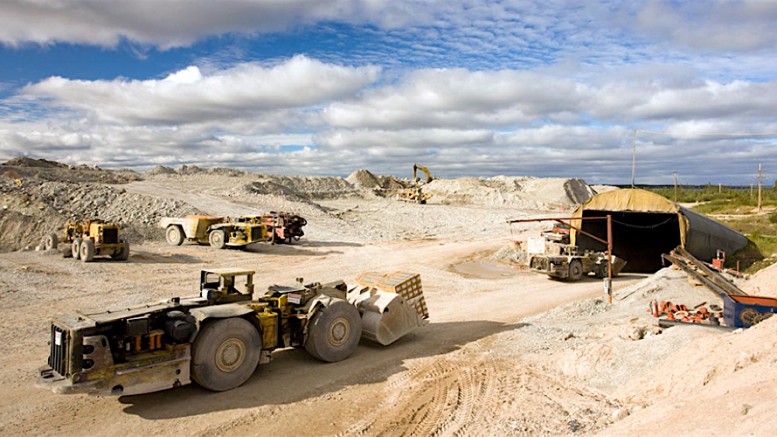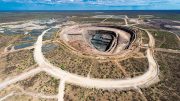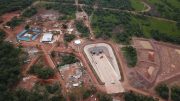The Northern Miner presents the top-10, Canada-headquartered mining companies by market capitalization, as of early July 2019.
1. Nutrien
Market cap: $41.8 billion
Nutrien (TSX: NTR; NYSE: NTR) is the world’s largest provider of crop inputs and services, and produces and distributes over 26 million tonnes of potash, nitrogen and phosphate products each year. In 2018, the company sold 13 million tonnes of potash, 10 million tonnes of nitrogen and 4 million tonnes of phosphate. It was formed in a 2018 merger between Potash Corp. of Saskatchewan — the world’s largest potash producer, second-largest phosphate producer and third-largest nitrogen producer — and Agrium, a retail supplier of agricultural products and service.
In February, Nutrien approved the purchase of up to 5% of its outstanding common shares over a one-year period through a normal course issuer bid, noting that the company’s “strong balance sheet and cash flow provide a significant opportunity to enhance shareholder value.” Nutrien repurchased 7% of its outstanding shares between February 2018 and February 2019. Last year, its first full year, the company posted adjusted earnings before interest, taxes, amortization and depreciation (EBITDA) of US$3.9 billion on sales of US$19.64 billion.
2. Barrick Gold
Market cap: $35.9 billion
Barrick Gold (TSX: ABX; NYSE: GOLD) has the greatest number of “tier-one” gold assets under management, and the lowest total cash cost among its senior gold mining peers. With its various joint-venture operations, Barrick also has the highest gold production from assets and mines under its management. The Barrick Gold and Randgold Resources merger took effect on Jan. 1, 2019, and created a gold company that owns five of the industry’s top-10, tier-one gold assets: Cortez and Goldstrike in Nevada; Kibali in the Democratic Republic of the Congo (45%); Loulo–Gounkoto in Mali (80%); and Pueblo Viejo in the Dominican Republic (60%).

Barrick Gold’s Cortez pit, looking north. Credit: Barrick Gold.
It also has two with the potential to become tier-one gold assets: Goldrush–Fourmile (100%) and Turquoise Ridge (75%), both in the United States.
Barrick recently struck a joint venture with Newmont Goldcorp, called Nevada Gold Mines, which will have three tier-one gold mines: Barrick’s Cortez; the combination of Barrick’s Goldstrike and Newmont’s Carlin; and Barrick’s Turquoise Ridge, with Newmont’s Twin Creeks. The joint-venture operations making up Nevada Gold Mines, owned 61.5% by Barrick and 38.5% by Newmont, produced more than 4 million oz. gold in 2018.
3. Teck Resources
Market cap: $17 billion
Teck Resources (TSX: TECK.B; NYSE: TECK) owns or has interests in 13 operating mines, a large metallurgical complex and several major development projects in the Americas, with business units focused on metallurgical coal, copper, zinc and energy. Last year, it posted record revenues of $12.6 billion, record gross profit before depreciation and amortization of $6.1 billion, record profit attributable to shareholders of $3.1 billion, or $5.41 per share, and record $6.2-billion EBITDA. Cash flow from operations came in at $4.4 billion, and the company lowered its outstanding debt by $1.4 billion.
4. Agnico Eagle Mines
Market cap: $15.8 billion
Agnico Eagle Mines (TSX: AEM; NYSE: AEM) has produced precious metals since 1957, and declared a cash dividend every year since 1983. It has mines in Canada, Finland and Mexico, as well as exploration activities in each of those countries, and in the U.S. and Sweden. Its newest mine, Meliadine in Nunavut, started commercial production in May. Last year, Agnico’s mines produced 1.63 million oz. gold, compared to its market guidance of 1.53 million ounces. It outperformed its 2018 cost guidance by 2%, producing gold at a total cash cost per oz. of US$637 on a by-product basis, versus its target of US$650 per ounce. Management expects to grow its payable gold production from 1.75 million oz. in 2019 to 2 million oz. in 2020.
5. Kirkland Lake Gold
Market cap: $11.9 billion
Kirkland Lake Gold (TSX: KL; NYSE: KL) has five underground gold mines and three mills in Canada and Australia, and is targeting production this year of between 950,000 and 1 million oz. gold at all-in sustaining costs (AISCs) of US$520-560 per ounce. The company was formed in 2016 through a merger of Canada’s Kirkland Lake Gold and Australia’s Newmarket Gold. Its two largest assets — the Macassa mine in northern Ontario and the Fosterville mine in Australia — both reported record gold production in the first quarter of 2019. Fosterville produced 128,445 oz. in the three months ended March 31 — more than double the 63,843 oz. in the first quarter of 2018 — while Macassa churned out 72,776 oz. gold, in a 35% increase from the year-earlier quarter’s 54,038 ounces.
6. First Quantum Minerals
Market cap: $8.5 billion
First Quantum Minerals (TSX: FM; US-OTC: FQVLF) operates eight mines in seven countries: Spain, Finland, Turkey, Mauritania, Australia, Zambia and Panama. Last year, over 90% of its revenues came from copper production, making it one of a handful of relatively pure-play copper companies. In 2018, it produced a record 605,853 tonnes copper at cash costs of US$1.28 per lb., and AISCs of US$1.74 per pound. Net earnings attributable to shareholders reached US$441 million, or 64¢ per share. Earlier this year, First Quantum celebrated the first ore through the mill at its massive Cobre Panama copper-moly-gold-silver mine in Panama, where it is ramping up to produce 300,000 tonnes copper annually by 2021 over a 40-year mine life, making it one of the world’s largest copper mines. First Quantum anticipates that the combined output from all of its mines will exceed 800,000 tonnes per year by 2021.
7. Kinross Gold
Market cap: $6.3 billion
Kinross Gold (TSX: K; NYSE: KGC) operates mines in Mauritania (Tasiast), Ghana (Chirano), Russia (Kupol and Dvolnoye), the U.S. (Fort Knox, Round Mountain, Bald Mountain) and Brazil (Paracatu). Last year, it produced 2.45 million equivalent oz. gold and set production records at Paracatu and Bald Mountain. It expects to produce 2.5 million equivalent oz. gold in 2019. In 2018 the company posted a net loss attributable to common shareholders of US$23.6 million, or 2¢ per share, compared to net earnings attributable to shareholders of US$445.4 million, or 36¢ per share, in 2017. The change owed to a drop in operating earnings, a US$97-million reversal of impairment charges recognized in 2017, in connection with the sale of the company’s interest in the Cerro Casale project in Chile, and higher income tax expenses in 2018.

Tasiast open pit operations. Credit: Kinross Gold.
Adjusted net earnings attributable to shareholders came in at US$128.1 million, or US10¢ per share, compared to US$178.7 million, or US14¢ per share, in 2017. The company is infamous for its US$7.1-billion acquisition in 2011 of Red Back Mining, which Kinross had to write down by 80% within two years. Over the past seven years, it has repaid US$1 billion in debt, and has no debt maturities until 2021.
8. Cameco
Market cap: $5.6 billion
Cameco (TSX: CCO; NYSE: CCJ), formed through the merger of two crown corporations in 1988, is one of the world’s largest providers of uranium. Cameco operates four active uranium mines — two in the U.S., one in Canada and one in Kazakhstan. Depressed uranium prices and continuing market uncertainty led the company to extend a production shutdown at its McArthur River–Key Lake operation last year, removing 18 million lb. uranium oxide annually from the market. It also lowered its annual 2018 dividend from 40¢ per share to 8¢ per share.
This year Cameco expects to incur between $130 million and $160 million in care and maintenance costs related to the suspension of production at its McArthur River–Key Lake mine and mill, Rabbit Lake mine and mill, and U.S. operations, although most of the costs will be incurred at McArthur River–Key Lake. The company holds 467 million lb. proven and probable reserves on three continents and is also a leading provider of nuclear fuel processing services, supplying much of the world’s reactor fleet.
9. Lundin Mining
Market cap: $5.4 billion
Lundin Mining (TSX: LUN) is a diversified base metals mining company with operations in Brazil (Chapada), Chile (Candelaria), Portugal (Neves-Corvo), Sweden (Zinkgruvan) and the U.S. (Eagle), primarily producing copper, nickel and zinc. Lundin Mining also holds an indirect 24% equity stake in the Freeport Cobalt Oy business, which includes a cobalt refinery in Kokkola, Finland.
The company recently acquired the Chapada open-pit, copper-gold mine from Yamana Gold for US$800 million, funded by cash-on-hand and Lundin Mining’s $550-million revolving credit facility. Yamana has a 2% net smelter return royalty on future gold production from the Suruca deposit, and contingent consideration of up to US$125 million over five years, if certain gold price thresholds are met, and contingent consideration of US$100 million on pyrite roaster construction. Lundin Mining posted net earnings from continuing operations in 2018 of US$215.4 million and ended the year with US$804.4 million in net cash.
10. B2Gold
Market cap: $4 billion
B2Gold (TSX: BTO; NYSE-AM: BTG) was founded in 2007 by the former management and technical teams of Bema Gold, and the world’s new senior gold producer posted record annual production in 2018 of 953,504 oz. gold at cash-operating costs of US$495 per oz., and AISCs of US$758 per ounce. It expects to produce between 935,000 and 975,000 oz. this year, at cash-operating costs of US$520 to US$560 per oz., and AISCs of US$835 to US$875 per ounce. Since 2016, the company has recorded a 74% production growth. It recently sold its La Libertad and El Limon mines in Nicaragua, and owns mines in Mali (Fekola), Namibia (Otjikoto) and the Philippines (Masbate). It has exploration projects in Burkina Faso (Kiaka and Toega) and Colombia (Gramalote).






Be the first to comment on "Top-10 Canadian miners by market cap"